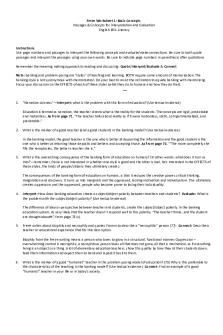7.4 Basic Concepts of Probability In class worksheet PDF

| Title | 7.4 Basic Concepts of Probability In class worksheet |
|---|---|
| Course | Math For The Life Sciences |
| Institution | Drexel University |
| Pages | 5 |
| File Size | 155.9 KB |
| File Type | |
| Total Downloads | 64 |
| Total Views | 158 |
Summary
In class worksheet...
Description
Section 7.4 Basic Concepts of Probability There are some basic rules of probability you need to be acquainted with in order to be able to calculate more complex probabilities. The Union Rule
P E F
If E and F are mutually exclusive,
Examples: 1. Two fair 6-sided dice are rolled. a. Find the probability of rolling a sum of 4.
b. Find the probability of rolling a sum of 11.
c. Find the probability of rolling between 5 and 8 (exclusive).
d. Find the probability the sum is 8 or both die show the same number.
2. One card is drawn from an ordinary deck of 52 cards. Find the probabilities of drawing the following cards. Note that spades and clubs are black cards, diamonds and hearts are red cards, and a face card is a king, queen, or jack. a. A diamond or a 7
b. A black card or an ace
c. A red card or a face card
The Complement Rule
PE '
and P E
Examples 1. Find the probability when two fair dice are rolled that the sum is less than 11.
2. Color blindness is an inherited characteristic that is more common in males than females. If M represents male and C represents color blindness, we can use the relative frequencies of the incidences of males and red green color blindness to get Given that P C .39 ,
PM C .035 and PM C .491 . Find the following probabilities: a.
P C '
b. P M
c. P M '
d. P M 'C '
Probability Distributions All of the examples we have done have been examples of what are called “discrete random variables” (there is another kind, called “continuous”, which we will discuss later). A description of the probabilities of each possible outcome of an experiment leads to what is called a probability distribution (for discrete random variables it is more specifically called a probability mass function, or pmf, for short). This can be written in a table or can be given as an equation. We won’t get to using equations to describe probabilities until chapter 8, so for now we will limit our discussion to describing probability distributions as tables. Valid probability distributions have the following properties: Let S be a sample space consisting of n distinct outcomes, s1 , s 2 ..., sn . An acceptable probability assignment consists of assigning to each outcome si a number pi (the probability of
si ) according to these rules: 1.
2.
Example:
a.
Write a probability distribution for the majors at the community college.
b. Find the probability that a randomly selected student is an engineering major.
c. Find the probability that student is a math major or a chemistry major....
Similar Free PDFs

Basic concepts of Logic
- 10 Pages

Basic Concepts in Soil Fertility
- 43 Pages

Basic Concepts IN Political Science
- 22 Pages

Basic Concepts of Gross Anatomy
- 2 Pages

R09 Probability Concepts Q Bank
- 20 Pages
Popular Institutions
- Tinajero National High School - Annex
- Politeknik Caltex Riau
- Yokohama City University
- SGT University
- University of Al-Qadisiyah
- Divine Word College of Vigan
- Techniek College Rotterdam
- Universidade de Santiago
- Universiti Teknologi MARA Cawangan Johor Kampus Pasir Gudang
- Poltekkes Kemenkes Yogyakarta
- Baguio City National High School
- Colegio san marcos
- preparatoria uno
- Centro de Bachillerato Tecnológico Industrial y de Servicios No. 107
- Dalian Maritime University
- Quang Trung Secondary School
- Colegio Tecnológico en Informática
- Corporación Regional de Educación Superior
- Grupo CEDVA
- Dar Al Uloom University
- Centro de Estudios Preuniversitarios de la Universidad Nacional de Ingeniería
- 上智大学
- Aakash International School, Nuna Majara
- San Felipe Neri Catholic School
- Kang Chiao International School - New Taipei City
- Misamis Occidental National High School
- Institución Educativa Escuela Normal Juan Ladrilleros
- Kolehiyo ng Pantukan
- Batanes State College
- Instituto Continental
- Sekolah Menengah Kejuruan Kesehatan Kaltara (Tarakan)
- Colegio de La Inmaculada Concepcion - Cebu










